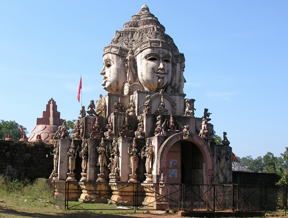 King of pilgrimages & origin of River Narmada
King of pilgrimages & origin of River Narmada
Amarkantak is a pilgrim town in Anuppur District in the state of Madhya Pradesh, India situated at an altitude of 1065 meters. A relatively off track destination, Amarkantak is a veritable paradise, with a salubrious climate and pictorial environs. Its ever-pervading air of composure, the grassy hills, woody backgrounds and the bewitching cascades make it a popular destination.
Also called “Teerthraj” (the king of pilgrimages), Amarkantak region is a unique natural heritage area and is the meeting point of the Vindhyas and the Satpuras, with the Maikal Hills being the fulcrum. This is where the Narmada River, the Sone River and Johila River emerge.
While the Narmada flows westwards from Amarkantak, the Sone flows towards the East. Amarkantak is indeed blessed by Nature. Holy ponds, lofty hills, forested surroundings, breathtakingly beautiful waterfalls and an ever-pervading air of serenity make Amarkantak a much sought-after destination for the religious-minded as well as for the nature-lover.
Sacred River
Among all the sacred rivers of India, the Narmada occupies a unique place. Legend has it that Lord Shiva blessed Narmada with unique purifying powers. Whereas to purify himself, a devotee requires to take one dip in the Holy Ganga, seven days’ prayers on the banks of Yamuna and three days prayers on the banks of Saraswati, the mere sight of Narmada is enough.
A charming folk tale describes the superiority of Narmada over Ganga. Once every year, after she herself is polluted beyond tolerance, Ganga visits Narmada dressed like a dark woman and takes a cleansing purifying dip in its waters! There are other rivers too, popular, romantic and life sustaining, each glamorized in the folk lore and history but none can match the mystique of Narmada.
The temperate climate and the equitable distribution of rain make Amarkantak an ideal plateau for dense vegetation cover.
Religious importance
Amarkantak is a place of worship for all the three worlds. Gods and Gandharvas (celestial beings), Asuras (demons), Saints and Sages have achieved great spiritual powers here. It is believed that who ever dies at Amarkantak is assured a place in heaven. If a woman makes offerings of fruits and flowers, she will gain the respect of her husband, and no doubt she will achieve a place in heaven.
When Lord Shiva destroyed Tripura (the three cities) by fire, the ashes of one fell upon Mount Kailash, the ashes of another fell upon Amarkantak, and the ashes of the third were saved by Lord Shiva and kept in heaven. The ashes that fell upon Amarkantak turned into crores of Shivalingas. Only one is visible at Jwaleshwar in Amarkantak.
Amarkantak is a Sanskrit word the literal meaning of which is immortal (amar) obstruction (kantak). The place was abode of gods but was disturbed by the hindrances of Rudraganas and hence called Amarkantak. The poet Kalidas has mentioned it as Amrakoot, which later became Amarkantak. Myth is that the dense forests of this region were full of mango (amra) trees.
Attractions
Dudh Dhara Falls: Dudh Dhara falls lies in the western edge of the Amarkantak valley in the midst of thick woods. Dudh literally stands for milk and the name itself suggest the nature of the gurgling streams of this pretty cascade.
Kabir Chabutra: Kabir Chabutra, which ideally means the platform of Saint Kabir, is situated 5 km from Amarkantak on the way to Bilaspur. This is one of the sacred places where Saint Kabir is said to have achieved salvation. Pilgrims coming to this place can also see the footwear of the saint kept inside a small temple near the chabutra.
This chabutra is mainly a small pond, where every morning between 9 am and 10 am, tourists can see white smoke screen spreading over the water. The Kabir Chabutra is the meeting place of three districts of Madhya Pradesh, namely Bilaspur, Anuppur and Dindori. Travelers can also see the Kabir Waterfalls in this region.
Sonemuda: Sonemuda is considered to be the place of origin of the Son River, which is located at a distance of around 1.5 km from the Narmadakund Temples. The Son River flows down from the Maikal Mountain in the form of waterfall that descends hundreds of feet. Tiny granules of gold can be found in this river, due to which, it is named as Son River.
Mai Ki Bagiya: Mai ki Bagiya is one of the prettiest locations in Amarkantak. Literally Bagiya means orchard and Mai ki Bagiya is a lovely stretch of trees, which is believed to be the playground of River Narmada. Legend has it that mother Narmada used to pluck flowers from this garden
A natural garden with wide varieties of shaded trees, this orchard proffers a nice walking trail in absolute serenity. The garden contains endless varieties of mangos, bananas and so many other fruit bearing trees along with a long stretch of flowery plants. Mai Ki Bagiya encompasses shrines, trees, a rain-fed kund and the banks of this holy kund is quite famous for large varieties of medicinal herbs and plants.
Kapil Dhara: Kapil Dhara, which is also known as Kapil Waterfall, is located just 6 km towards the north-west of the Narmadakund Temples. This waterfall is around 100 ft tall and is surrounded by dense forests and mountains. Kapil Dhara is named after the sage Kapil Muni, who is believed to have meditated at this place.
Narmadakund and Temples: Narmadakund is the place of origin of river Narmada, which is surrounded by 16 major stone temples. This place covers around 6 acres of land and comprises over 23 statues of various deities. In the central position, there is an eleven corner kund, which is around 500 ft long. This eleven cornered kund is also known as Narmada Udgam or Bisha Yantram.
Best time to visit
Best season to visit Amarkantak is all through the year. October to March is cool and pleasant. March to September is good for all kinds of tourist activities.
How to reach
By Train: The nearest railhead to Amarkantak is Pendra Road at a distance of 17 km from the heart of the city. Anuppur at distance of 48 km from Amarkantak is also convenient.
By Air: The nearest airport is at Jabalpur, 245 km away. Pre-paid taxi services are available from airport to Amarkantak
By Bus: There are state owned transport buses from Pendra Road, Shahdol and Bilaspur. Amarkantak is connected by buses to Jabalpur (245 km), Rewa (261 km) and Shahdol (67 km).






